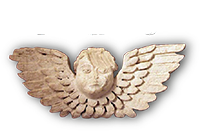BROKEN TOILET LEADS TO 2,000 YEARS OF HISTORY: INCREDIBLE FIND UNEARTHS ANCIENT TOMB, ROMAN GRANARY AND ETCHINGS FROM THE KNIGHTS TEMPLAR BENEATH ITALIAN RESTAURANT
A search for a sewage pipe beneath an Italian restaurant yielded two centuries worth of history.
Lucian Faggiano bought the building in Lecce, Puglia in the south of Italy and had planned to turn it into a trattoria – but renovations were put on hold when he discovered a toilet on the site was blocked.
And while attempting to fix the toilet he dug into a Messapian tomb built 2,000 years ago, a Roman granary, a Franciscan chapel, and even etchings thought to be made by the Knights Templar.
In a bid to stop the sewage backing up, Mr Faggiano, 60, and his two sons dug a trench and instead of isolating the offending pipe found underground corridors and rooms beneath the property on 56 Via Ascanio Grandi,The New York Times reported.
The search for the pipe began at the turn of the millennium.
Lecce, at the heel of Italy’s ‘boot’ was once a crossroads in the Mediterranean and an important trading post for the Romans.
But the first layers of the city date to the time of Homer, according to local historian Mario De Marco.
It is not unusual for religious relics to turn up in fields or in the middle of the city itself, which has a mixture of old architecture
For example, a century ago, a Roman amphitheatre was recently found beneath a marble column bearing the statue of Lecce’s patron saint, Orontius in the main square and recently a Roman temple was found under a car park.
‘Whenever you dig a hole, centuries of history come out,’ said Severo Martini, a member of the City Council.
Mr Faggiano asked his sons to help fix the problem with the plumbing so he could accelerate the opening of his restaurant, in a building that looked like it was modernised.
But when they dug down they hit a floor of medieval stone, beneath which was a Messapian tomb, built by people who lived in the area before the birth of Jesus.
Legend has it the city was founded by the Messapii, who are said to have been Cretans in Greek records, but then the settlement was called Sybar.
Upon further investigation, the family team also discovered a Roman room that was used to store grain, and a basement of a Franciscan convent where nuns were thought to have once prepared the bodies of the dead.
Afraid of costs and the delay in opening the restaurant, Mr Faggiano initially kept his amateur archaeology a secret from his wife, in part perhaps because he was lowering his youngest son, Davide, 12 though small gaps in the floor to aid his work.
But his wife, Anna Maria Sanò suspected the work was more complex than it appeared thanks to the amount of dirty clothes she was washing, and because of dirt and debris being taken away.
Investigators shut down the site, warning Mr Faggiano he was conducting an unofficial archaeological dig.
After a year, work continued but had to be overseen by heritage officials who witnessed the emergence of Roman devotional bottles, ancient vases and a ring with Christian symbols as well as hidden frescoes and medieval pieces.
Retired cultural heritage official, Giovanni Giangreco, who was involved with the excavation, said: ‘The Faggiano house has layers that are representative of almost all of the city’s history, from the Messapians to the Romans, from the medieval to the Byzantine time.’
Despite bearing the financial load of the dig, the family became fascinated about the history beneath their building and made ends meet by renting rooms in it.
Mr Faggiano admits to becoming obsessed with the project, but still wanted to open his restaurant.
He said: ‘At one point, I couldn’t take it anymore I bought cinder blocks and was going to cover it up and pretend it had never happened.’
Eight years after it was meant to open as a restaurant, the incredible building has been turned into Museum Faggiano and a number of staircases allow visitors to travel down through time to visit the ancient underground chambers.
However, Mr Faggiano hasn’t given up on his culinary dream and is planning on opening a restaurant at a less complex location – even though he finally found the troublesome sewage pipe.
http://www.dailymail.co.uk/sciencetech/article-3047560/Broken-toilet-leads-2-000-years-history-Incredible-unearths-ancient-tomb-Roman-granary-etchings-Knights-Templar-beneath-Italian-restaurant.html
